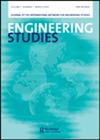History of Engineering (and Some of Its Uses)
IF 1.3
3区 工程技术
Q2 EDUCATION, SCIENTIFIC DISCIPLINES
引用次数: 0
Abstract
Before getting to this issue’s contents I would first like to toast some good news for the journal. Every year Taylor & Francis sends me a packet of statistics, surveys, pie charts and the like showingwhere the journal stands. This is good information tohave, and I encourage all authors and readers to accept the publisher’s requests to fill in surveys about the journal – wedependon that kindof feedback. This year thepacket containeda couplenice treats. In particular, our impact factor roughly quadrupled from 2017 to 2018, to a value of 0.952. We should, of course, treat such figureswith due caution – that is one of themain lessons of our field, after all. But I think the increase does show that people are engagingwith the journal’s content. That interpretation is reinforced by the figures for downloads of our articles, which havebeengrowingby ∼25%per year since2012. That is agreat long-term trend that I hope will continue. So if you have written something on the practice and culture of engineering and arewonderingwhere to send it – well, I hope these figures give you some idea that this journal is drawing attention and sparking conversation.工程史(及其一些用途)
在谈到本期的内容之前,我首先想为杂志祝酒一些好消息。Taylor&Francis每年都会给我寄一包统计数据、调查、饼图等,展示杂志的位置。这是一个很好的信息,我鼓励所有作者和读者接受出版商的要求,填写关于该杂志的调查——我们依赖于这种反馈。今年的包里有两种美味的食物。特别是,从2017年到2018年,我们的影响因子大约翻了四番,达到0.952。当然,我们应该谨慎对待这些人物——毕竟这是我们这个领域的主要教训之一。但我认为,这一增长确实表明人们对该杂志的内容产生了兴趣。自2012年以来,我们文章的下载量以每年约25%的速度增长,这一解释得到了加强。这是一种长期趋势,我希望这种趋势将继续下去。因此,如果你已经写了一些关于工程实践和文化的文章,并想在这里发送它——好吧,我希望这些数字能让你知道这本杂志正在引起关注并引发对话。
本文章由计算机程序翻译,如有差异,请以英文原文为准。
求助全文
约1分钟内获得全文
求助全文
来源期刊

Engineering Studies
ENGINEERING, MULTIDISCIPLINARY-HISTORY & PHILOSOPHY OF SCIENCE
CiteScore
3.60
自引率
17.60%
发文量
12
审稿时长
>12 weeks
期刊介绍:
Engineering Studies is an interdisciplinary, international journal devoted to the scholarly study of engineers and engineering. Its mission is threefold:
1. to advance critical analysis in historical, social, cultural, political, philosophical, rhetorical, and organizational studies of engineers and engineering;
2. to help build and serve diverse communities of researchers interested in engineering studies;
3. to link scholarly work in engineering studies with broader discussions and debates about engineering education, research, practice, policy, and representation.
The editors of Engineering Studies are interested in papers that consider the following questions:
• How does this paper enhance critical understanding of engineers or engineering?
• What are the relationships among the technical and nontechnical dimensions of engineering practices, and how do these relationships change over time and from place to place?
 求助内容:
求助内容: 应助结果提醒方式:
应助结果提醒方式:


